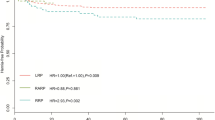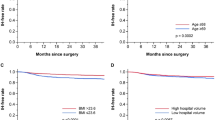Abstract
Background
Postoperative inguinal hernia (IH) is a non-negligible sequelae with a wide array of rates after robot-assisted laparoscopic radical prostatectomy (RALP). Our aim was to evaluate the incidence and risk factors of postoperative IH development in men undergoing RALP.
Methods
A retrospective analysis of 839 patients “541 of conventional-RALP (C-RALP), and 298 of Retzius sparing-RALP (RS-RALP)” received treatment of prostate cancer between 2005 and 2016 and met with our inclusion criteria was performed. Primary endpoint was incidence of IH after RALP, while secondary endpoint was to assess risk factors of IH occurrence.
Results
Overall incidence of postoperative IH was 6.3% (53 out of 839). Mean follow-up period and median time of IH development were 24.1 and 14.0 months, respectively. Among patients who developed IH, there was a higher incidence in C-RALP compared to RS-RALP, (79.2 vs 20.8%, respectively, P = 0.02). Multivariate analysis showed that BMI group (HR 0.471, P = 0.023) and C-RALP (HR 2.834, P = 0.002) were significant predictors of IH development. Kaplan–Meier curve showed that 3-year IH-disease progression free rate was significantly higher after RS-RALP compared to C-RALP (94.2 vs 71.6%, respectively, P < 0.001), likewise in obese versus non-obese patients (87.7 vs 76.6%, respectively, P < 0.003).
Conclusion
Our study showed that overall incidence of IH was 6.3% after RALP. Nevertheless, RS-RALP carries a lower incidence of IH after surgery, while C-RALP and low BMI are predictors of IH development.


Similar content being viewed by others
References
Zhu S, Zhang H, **e L, Chen J, Niu Y (2013) Risk factors and prevention of inguinal hernia after radical prostatectomy: a systematic review and meta-analysis. J Urol 189:884–890
Lughezzani G, Sun M, Perrotte P et al (2010) Comparative study of inguinal hernia repair rates after radical prostatectomy or external beam radiotherapy. Int J Radiat Oncol Biol Phys 78:1307–1313
Stranne J, Hugosson J, Iversen P, Morris T, Lodding P (2005) Inguinal hernia in stage M0 prostate cancer: a comparison of incidence in men treated with and without radical retropubic prostatectomy—an analysis of 1105 patients. Urology 65:847–851
Stranne J, Hugosson J, Lodding P (2006) Post-radical retropubic prostatectomy inguinal hernia: an analysis of risk factors with special reference to preoperative inguinal hernia morbidity and pelvic lymph node dissection. J Urol 176:2072–2076
Abe T, Shinohara N, Harabayashi T et al (2007) Postoperative inguinal hernia after radical prostatectomy for prostate cancer. Urology 69:326–329
Lin BM, Hyndman ME, Steele KE et al (2011) Incidence and risk factors for inguinal and incisional hernia after laparoscopic radical prostatectomy. Urology 77:957–962
Stranne J, Johansson E, Nilsson A et al (2010) Inguinal hernia after radical prostatectomy for prostate cancer: results from a randomized setting and a nonrandomized setting. Eur Urol 58:719–726
Shimbo M, Endo F, Matsushita K et al. (2017) Incidence, risk factors and a novel prevention technique for inguinal hernia after robot-assisted radical prostatectomy. Urol Int 98:54–60
Jeong W, Araki M, Park SY et al (2010) Robot-assisted laparoscopic radical prostatectomy in the Asian population: modified port configuration and ultradissection. Int J Urol 17:297–300
Lim SK, Kim KH, Shin TY et al (2014) Retzius-sparing robot-assisted laparoscopic radical prostatectomy: combining the best of retropubic and perineal approaches. BJU Int 114:236–244
Heidenreich A, Bastian PJ, Bellmunt J et al (2013) EAU guidelines on prostate cancer. Part 1: screening, diagnosis, and local treatment with curative intent-update 2013. Eur Urol 65:124–137
Matsubara A, Yoneda T, Nakamoto T et al (2007) Inguinal hernia after radical perineal prostatectomy: comparison with the retropubic approach. Urology 70:1152–1156
Lee DH, Jung HB, Chung MS, Lee SH, Chung BH (2013) Patent processus vaginalis in adults who underwent robot-assisted laparoscopic radical prostatectomy: predictive signs of postoperative inguinal hernia in the internal inguinal floor. Int J Urol 20:177–182
Nielsen ME, Walsh PC (2005) Systematic detection and repair of subclinical inguinal hernias at radical retropubic prostatectomy. Urology 66:1034–1037
Nyhus LMCR (1989) Inguinal hernia. Lippincott Williams & Wilkins, Philadelphia
Kim Sung Han, Kim HGJ, Jeong In Gab, Lee Eunsik (2008) The incidence and risk factors for inguinal hernia after radical retropubic prostatectomy. Korean J Urol 49:11
Finley DS, Savatta D, Rodriguez E, Kopelan A, Ahlering TE (2008) Transperitoneal robotic-assisted laparoscopic radical prostatectomy and inguinal herniorrhaphy. J Robot Surg 1:269–272
Koie T, Yoneyama T, Kamimura N, Imai A, Okamoto A, Ohyama C (2008) Frequency of postoperative inguinal hernia after endoscope-assisted mini-laparotomy and conventional retropubic radical prostatectomies. Int J Urol 15:226–229
Asimakopoulos AD, Miano R, Galfano A et al (2015) Retzius-sparing robot-assisted laparoscopic radical prostatectomy: critical appraisal of the anatomic landmarks for a complete intrafascial approach. Clin Anat 28:896–902
Galfano A, Di Trapani D, Sozzi F et al (2013) Beyond the learning curve of the Retzius-sparing approach for robot-assisted laparoscopic radical prostatectomy: oncologic and functional results of the first 200 patients with ≥1 year of follow-up. Eur Urol 64:974–980
Wu JC-H, Ou Y-C (2012) Inguinal hernia after a radical prostatectomy for localized prostate cancer. Urol Sci 23:1–4
Zendejas B, Hernandez-Irizarry R, Ramirez T et al (2014) Relationship between body mass index and the incidence of inguinal hernia repairs: a population-based study in Olmsted County, MN. Hernia 18:283–288
Regan TC, Mordkin RM, Constantinople NL, Spence IJ, Dejter SW, Jr (1996) Incidence of inguinal hernias following radical retropubic prostatectomy. Urol 47:536–537
Lodding P, Bergdahl C, Nyberg M, Pileblad E, Stranne J, Hugosson J (2001) Inguinal hernia after radical retropubic prostatectomy for prostate cancer: a study of incidence and risk factors in comparison to no operation and lymphadenectomy. J Urol 166:964–967
Sekita N, Suzuki H, Kamijima S, Chin K, Fujimura M, Mikami K et al. (2009) Incidence of inguinal hernia after prostate surgery: open radical retropubic prostatectomy versus open simple prostatectomy versus transurethral resection of the prostate. Int J Urol 16:110–113
Yoshimine S, Miyajima A, Nakagawa K, Ide H, Kikuchi E, Oya M (2010) Extraperitoneal approach induces postoperative inguinal hernia compared with transperitoneal approach after laparoscopic radical prostatectomy. Jpn J Clin Oncol 40:349–352
Author information
Authors and Affiliations
Corresponding author
Ethics declarations
Conflict of interest
Nothing to declare.
Ethical approval
All procedures performed in studies involving human participants were in accordance with the ethical standards of the institutional and national research committee with the 1964 Helsinki declaration and its later amendments comparable ethical standards.
Informed consent
No informed consent.
Rights and permissions
About this article
Cite this article
Chang, K.D., Abdel Raheem, A., Santok, G.D.R. et al. Anatomical Retzius-space preservation is associated with lower incidence of postoperative inguinal hernia development after robot-assisted radical prostatectomy. Hernia 21, 555–561 (2017). https://doi.org/10.1007/s10029-017-1588-9
Received:
Accepted:
Published:
Issue Date:
DOI: https://doi.org/10.1007/s10029-017-1588-9




